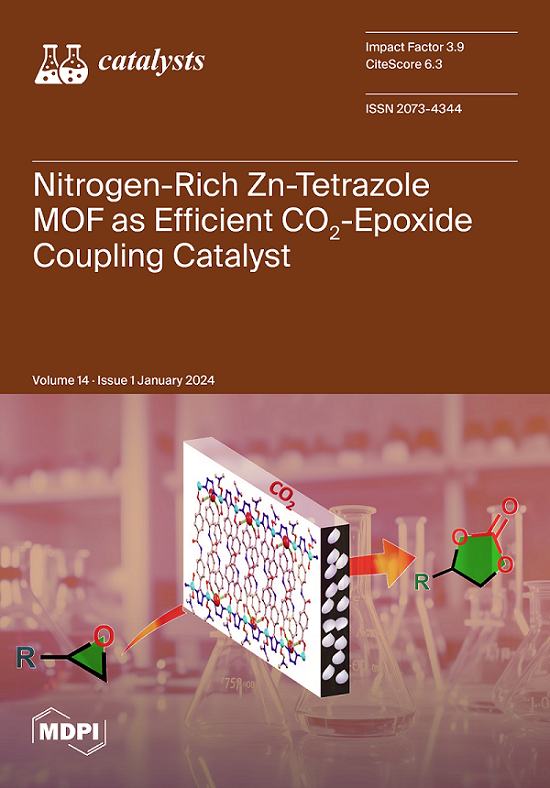在二氧化碳加氢反应中使用一体化方法制备的支撑镍和钴催化剂的比较研究:使用(聚)乙烯醇 (PVA) 作为添加剂的影响
IF 4
3区 化学
Q2 CHEMISTRY, PHYSICAL
引用次数: 0
摘要
制备了两个系列的 Ni 和 Co 催化剂,并对其在 La-Al2O3 上的二氧化碳加氢反应进行了研究。根据 CO2 转化率和产物(CH4 和 CO)产率随反应温度的变化情况,以及比活度(TOF)和表观活化能,对催化性能进行了评估。在 240-265 °C 温度下,CH4 是两种金属都偏爱的产物,而 Ni 形成 CH4 的 TOF 比 Co 高约三倍。研究还发现了金属颗粒尺寸的影响,随着平均金属尺寸的减小,镍和钴形成 CH4 的 TOF 都会减小。相反,对于 Ni 粒子尺寸最小的催化剂,随着粒子尺寸的减小,CO 生成的 TOF 有增加的趋势。镍和钴的表观活化能非常相似,当金属分散度增加时,表观活化能明显降低至 73-79 kJ/mol 的值。催化剂的制备采用了多合一方法,其中(聚)乙烯醇(PVA)是一种关键添加剂,使我们能够提高镍和钴的分散度,从而制备出非常有效的催化剂。这项比较研究是对现有文献中基于这些金属的催化剂在严格相同的反应条件下运行的少数研究的补充。本文章由计算机程序翻译,如有差异,请以英文原文为准。
Comparative Study of Supported Ni and Co Catalysts Prepared Using the All-in-One Method in the Hydrogenation of CO2: Effects of Using (Poly)Vinyl Alcohol (PVA) as an Additive
Two series of Ni and Co catalysts supported onto La-Al2O3 were prepared and the CO2 hydrogenation reactions investigated. The catalytic performance was evaluated in terms of the evolution with the reaction temperature of the CO2 conversion and product (CH4 and CO) yields, as well as specific activities (TOF) and apparent activation energies. CH4 was the favored product over both metals while the TOF for CH4 formation was about three times higher for Ni than Co at 240–265 °C. Metallic particle size effects were found, with the TOF for CH4 formation decreasing over both Ni and Co as the mean metallic size decreased. In contrast, the TOF for CO formation tended to increase at a decreasing particle size for the catalysts with the smallest Ni particle sizes. The apparent activation energies for Ni and Co were very similar and significantly decreased to values of 73–79 kJ/mol when the metallic dispersion increased. The catalysts were prepared using the all-in-one method, resulting in (poly)vinyl alcohol (PVA) being a key additive that allowed us to enhance the dispersion of Ni and Co to give very effective catalysts. This comparative study joins the few existing ones in the literature in which catalysts based on these metals operated under strictly the same reaction conditions.
求助全文
通过发布文献求助,成功后即可免费获取论文全文。
去求助
来源期刊

Catalysts
CHEMISTRY, PHYSICAL-
CiteScore
6.80
自引率
7.70%
发文量
1330
审稿时长
3 months
期刊介绍:
Catalysts (ISSN 2073-4344) is an international open access journal of catalysts and catalyzed reactions. Catalysts publishes reviews, regular research papers (articles) and short communications. Our aim is to encourage scientists to publish their experimental and theoretical results in as much detail as possible. Therefore, there is no restriction on the length of the papers. The full experimental details must be provided so that the results can be reproduced.
 求助内容:
求助内容: 应助结果提醒方式:
应助结果提醒方式:


